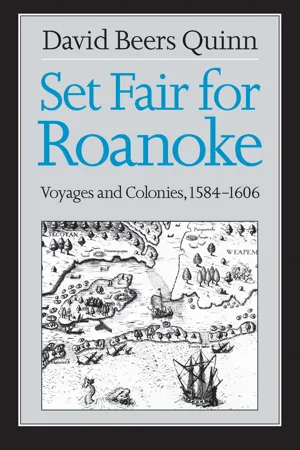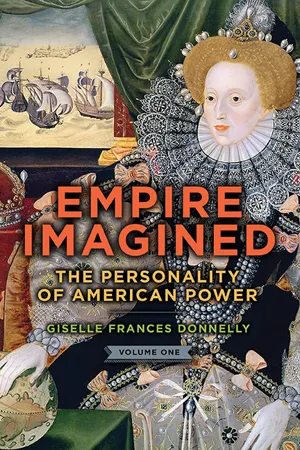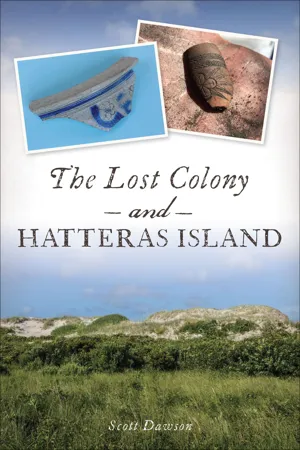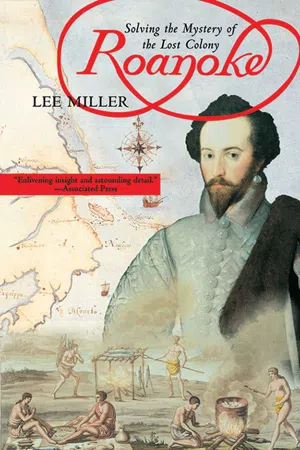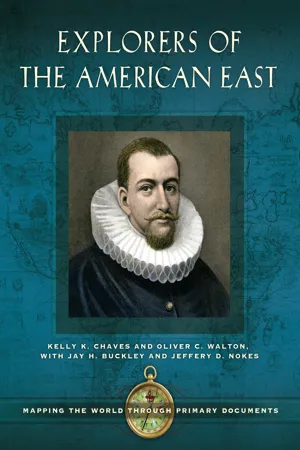History
Lost Colony of Roanoke
The Lost Colony of Roanoke refers to the mysterious disappearance of a group of English settlers in the late 16th century. The colony was established on Roanoke Island, off the coast of present-day North Carolina, and was led by John White. When White returned from a supply trip, the settlers had vanished without a trace, leading to enduring speculation and mystery surrounding their fate.
Written by Perlego with AI-assistance
Related key terms
Related key terms
1 of 4
Related key terms
1 of 3
7 Key excerpts on "Lost Colony of Roanoke"
- eBook - ePub
Inventing Americans in the Age of Discovery
Narratives of Encounter
- Michael Householder(Author)
- 2016(Publication Date)
- Routledge(Publisher)
It is this mixture of motives that must be considered as the background for the ultimate failure of England’s third attempt to establish a settlement in North America, this time on a small island off the coast of what is today known as North Carolina. English explorers operating under a patent granted to Walter Raleigh used the local Algonquian word and called it Roanoke. 1 For many readers, the name itself conjures a compelling sense of mystery and tragedy. The story of the so-called Lost Colony of Roanoke continues to be a staple of U.S. grade school history textbooks, folklore, and the tourist trade. As Robert Arner has shown, the Roanoke episode’s images of vacated settlements, ransacked dwellings, and cryptic messages carved on trees have inspired generations of readers and writers to imagine the collective fate of 117 men, women, and children abandoned without adequate supplies or protection. Even more compelling, however, is the story’s emblematically haunting lack: the absence of any graves or bones. Did the colonists, weakened by hunger and disease, retreat to the protection of the nearby Algonquian village of Croatan, as the colony’s leaders had planned in case of emergency? Or did they disperse into the countryside in a desperate attempt to find food? Once escaped from Roanoke, did they starve? Were they attacked and killed? Or did they assimilate into the indigenous population? This gap in the historical record has provoked numerous and varied acts of inventive cultural production. Michael Leroy Oberg describes an especially rich example in his excellent study of Roanoke and its cultural meaning, The Head in Edward Nugent’s Hand: Roanoke’s Forgotten Indians. Oberg describes the excitement created in 1937 by dozens of rocks scattered throughout the southern backcountry with inscribed messages purported to be from Ananias Dare and other Lost Colonists (139–42) - eBook - ePub
Seasons of Misery
Catastrophe and Colonial Settlement in Early America
- Kathleen Donegan(Author)
- 2013(Publication Date)
- University of Pennsylvania Press(Publisher)
Moreover they indicate serious breaches in the ability to interpret or account for events in the first English incursion into Native America, while also emphasizing the proximity of violence and indeterminacy. The stories are left unresolved; either the corpse silently absorbs the unreadable narrative into itself or the body goes missing, leaving no trail behind. These abandonments indicate that the cultural longevity and elaboration of the mystery of the Lost Colony is a legend that screens but also repeats a suppressed history of other people left behind in Virginia. In 1587 John White led yet another group of English colonists to try again to plant a permanent and self-perpetuating English settlement in North America. The ships that brought these colonists were the sixth round to arrive at Roanoke in three years: Barlowe's, Lane's, Drake's, the supply ship, Grenville's, and now White's. White took passage on four of these voyages, as did Manteo, who accompanied him. 70 After Lane set the deadly terms of Anglo-Indian engagement with the murder of Pemisapan, Roanoke had grown increasingly dangerous for the English with each arrival. Although White and his company originally planned to settle in the Chesapeake, they first stopped in Roanoke to check on the men Grenville had left garrisoned there. As members of Lane's colony, both White and Manteo knew the situation created by the raid on Dasemunkepeuc and Pemisapan's murder, but somehow they thought Grenville's men were still alive, albeit in need of relief. Even before reaching the fort, however, it was clear to White that they were mistaken, seeing no “signe that they had bene there, saving only we found the bones of one of those fifteen, which the Savages had slaine long before” (524). This was the third time English people had found the same patch of land mysteriously forsaken in two years. In 1586 the supply ship found Roanoke deserted by Lane's colony - eBook - ePub
Set Fair for Roanoke
Voyages and Colonies, 1584-1606
- David Beers Quinn(Author)
- 2017(Publication Date)
- The University of North Carolina Press(Publisher)
The Roanoke colonists and their planners were unable to achieve the ends they set for themselves. Although a small party could coast the southern part of Chesapeake Bay and penetrate the interior to the south of it in 1585–86, successive attempts to return there by sea were frustrated by inefficiency. The Lost Colonists were left to disappear without any effective attempt to find them for nearly twenty years. This fact (combined with Sir Walter Ralegh’s self-interest) demonstrated that neither the will nor the means to explore further were present until prestige factors came into play after the Spanish war ended. The Roanoke experiments, however, did provide at least some inkling of the necessity for long-term and substantial deployment of capital resources if colonization was to be effectively attempted, but it should not have taken twenty years for this to sink in.War, it is true, frustrated expeditions by both England and Spain that would have made the Chesapeake a wartime base for one power or the other. But after 1590, down to the Treaty of London in 1604, either side should have been able to carry out some part of its plans without affecting its war effort significantly, even if in the years before 1590 the exploitation of North America for naval purposes was not feasible. Lassitude overtook Spanish plans. English attention was diverted by Dutch successes in the East, and they moved to emulate them there rather than intervene before 1607 in North America.There were positive results, too, from the Roanoke voyages. The maintenance of more than a hundred men for over ten months on Roanoke Island in 1585–86 indicated that Englishmen could live in North America, even if the experience of the early Jamestown colonists suggested the contrary. The introduction of European epidemic diseases by the same Roanoke colonists was not regarded as significant. If it was regarded at all it would have been thought to have been a good thing, a means of clearing the original occupants from soil it was thought they did not effectively exploit. There was little awareness of the complications of introducing a progressive intrusive series of colonies into a closed Native American society, every inch of whose soil was part of the ideological property of its inhabitants. Indians, if they would not move, might have to be removed. Or they might, in Thomas Harriot’s view, be introduced to the benefits of European civilization and religion and remain in substantial parts of their own territory, even if full assimilation was rarely contemplated. The Roanoke voyages initiated for the English the intrusion that in the relatively short run was to remove most of the eastern Indians by death or their relegation to scarcely viable reservations inside their former territories. There were cultural exchanges both in 1584–87 and after 1607. The Indians were to master the use of metal tools and weapons; the English were to learn how to cultivate corn and other Indian horticultural novelties. But neither exchanged enough of each other’s cultural heritage to make the exchange a radical, or, from the Indian perspective, a fair one. The idealistic view, as it may be regarded, of John White was scarcely to be implemented. - eBook - ePub
Empire Imagined
The Personality of American Power, Volume One
- Giselle Frances Donnelly(Author)
- 2022(Publication Date)
- SUNY Press(Publisher)
6 THE ROANOKE COLONY In the spring of 1588, Sir Richard Grenville, one of the foremost sailors of the Elizabethan age and close associate of Francis Drake and Sir Walter Ralegh, readied a small fleet of seven ships, including the queen’s twenty-two-gun Tiger, for the reinforcement and provisioning of the first English permanent colony in North America, at Roanoke on the barrier islands of what today is North Carolina. Grenville’s preparations were nearing completion at the end of March, when the privy council intervened and ordered Grenville “to forebeare to go his intended voyage.” In the season of the Spanish Gran Armada, “Her Majesty dothe receave dayly advertisement of the preparations of the King of Spayne to increase, whereupon it is also thought necessary her Navyes on the seas should be reinforced and strengthened, and to that end order is given bothe for the staye of all shippes in the port townes of the Realme, and to the said townes to furnish a certain number of vessels, &c.” Grenville, lord of the manor of Bideford in north Devon, was “to have shippes so by him prepared to be in readynes to ioyne with her Majesties Navye as shalbe directed hereafter.” 1 Thus was the Roanoke colony, established the previous year, “lost,” or, as Kenneth Andrews mordantly put it, “effectively sentenced to death.” 2 The Roanoke effort was a product of the developing war with Spain and finally the victim of it: intended, first of all, as a potential haven for English privateers hoping to intercept King Philip’s treasure fleets, a forward base in the New World, Roanoke had to be sacrificed to defend the home waters from the threat of the Gran Armada. The colony was an expression of the expanding scope of English strategists but also of the limits of English military, economic, and other means - eBook - ePub
- Scott Dawson(Author)
- 2020(Publication Date)
- The History Press(Publisher)
The fifteen English soldiers left behind were attacked by Secotan warriors from Dasamonquepeu. At least two were killed, and the others fled east from Roanoke Island in a small boat, never to be seen or heard from again.Passage contains an image
Chapter 5THE “LOST” COLONY1587The fourth English voyage to the New World was the only one meant to last. Therefore, it was the first English voyage to bring women and children. The three previous voyages were military operations and established trade outposts. Even though the English military had found an excellent coastline for privateering the Spanish, the 1587 colony was not looking to loot ships. This group was looking for a deep harbor to set up a thriving port town. The transatlantic ships of the sixteenth century had deep drafts, and as such, they could not easily get in and out of the shallow sound around Roanoke Island. For this reason, the 1587 colony actually planned to settle farther north in the Chesapeake Bay area, which had a deeper harbor and reports of larger pearls. It was a perfect place to set up a port town. The colonists planned to briefly stop by Roanoke just long enough to pick up the fifteen men left there by Grenville the year before. Remember, they had no idea the fate that had befallen Grenville’s fifteen soldiers. This was their plan, but almost nothing went right on this voyage from the beginning to the end. Simon Fernando, who was an excellent pilot but a former pirate, was selected to guide the colony to the New World; however, his actions ultimately proved that he was intent on sabotaging the success of the colony.In the spring of 1587, at the start of the new year, the fourth English voyage to the New World embarked on its journey. It should be noted that New Year’s prior to 1742 was celebrated on March 25, not January 1. For those unaware of this fact, the English dates can be confusing.The voyage consisted of three ships: the Lion - eBook - ePub
Roanoke
Solving the Mystery of the Lost Colony
- Lee Miller(Author)
- 2012(Publication Date)
- Arcade(Publisher)
PART ONE
A CASE OF MISSING PERSONS
Passage contains an image
1 THE DISAPPEARANCE
Roanoke Island, North America—July 1587. A mystery is unfolding. One hundred and seventeen people have landed on a remote island off the North American coast. The men, women, and children, sent out by Sir Walter Raleigh, are the first English colonists in America. Despite the care taken for their safety, the explicit instructions, the plans for provisions, all will vanish. The only known survivor will be their Governor, John White — an artist and veteran of Raleigh’s previous Roanoke expeditions. He had known, from the moment they landed, that they could not survive on Roanoke Island.The commander of the ship that brought them there reported nothing amiss. In the weeks before he left them, the colonists had begun to repair the houses of an abandoned English fort. New cottages were constructed of brick and tile,1 and on August 18, White’s daughter Eleanor and husband Ananias Dare became the parents of a baby girl. Christened Virginia, she was the first English child born in North America. Several days later, another celebration. A boy was delivered to Dyonis and Margery Harvie.2And yet the ship’s captain was mistaken, for something was wrong. Terrible events had been set in motion from which there would be no escape. No one on the island knew what form it would take or when it would strike. Defenseless and impotent, they could only wait. In one of the last glimpses we have of them, it has already begun: colonist George Howe has been found dead, floating facedown among the reeds along the shore. With time running out, an envoy is urgently dispatched for help to the neighboring Secotan nation through an Indian liaison named Manteo. There is no response.August 27. At the height of the turmoil John White abruptly abandons the island. He leaves behind his daughter Eleanor, her baby Virginia, relatives and close friends, and sails back to England, pledging to return within three months. It is a promise he fails to keep. - eBook - ePub
Explorers of the American East
Mapping the World through Primary Documents
- Kelly K. Chaves, Oliver C. Walton(Authors)
- 2018(Publication Date)
- ABC-CLIO(Publisher)
Tiger account. Second, it reveals the English desperation to find the copper mine of which they had heard tales from their Native informants. This theme is returned to explicitly by Lane in his reflections on the expedition and the prospects for the colony in general. It has two explanations. The first is that Lane recognized that the colony needed some way of generating income in order to be viable, whether that was a lucrative trade route to China (“the South sea”) or a rich mine. Second, this reflects an envious comparison with the Spanish finds of gold and silver in Mexico and Peru. The English found neither in North America, and the hope attached to this supposed copper mine seems out of proportion to the value of the commodity.Lane is quite categorical about the limitations on colonization and exploration. They had failed to find the copper mine because of their limited food supply and the deteriorating political relations with the Indigenous people. Roanoke lacked a decent harbor, which meant that it was hard to resupply and would not be suitable as a base for raiding Spanish colonies and shipping to the south to earn an income by those means. Most fundamental, Lane also lacked the manpower and the supplies, including small but seaworthy vessels, to explore farther and transplant the colony to a more promising location. One important implication that Lane accepted was that English colonization would have to be one of settlement, at least in part, rather than Spanish-style conquest.36. Ralph Lane: Relations with Native Tribes INTRODUCTIONThis extract is from the second part of Lane’s report, in which he explains the deteriorating relationships with the Native people and the final decision to abandon the colony. Though separated by many pages, the narrative here overlaps with that in the previous extract, since it describes Pemisapan/Wingina’s intrigues against the English in the spring of 1586; the voyage from which Lane returns was the expedition up the Roanoke River, which dates the exposure of Pemisapan’s “bruite,” or rumor of Lane’s death, to the start of April.With Lane’s jumbled approach to writing, the text also refers back to events that immediately preceded the expedition up the Roanoke River. Lane had previously journeyed up the Chowan River, where he had broken up a conference of Native tribes that at Pemisapan’s instigation might have united against the English. Lane had diffused the nascent alliance by marching straight in and capturing the Chawanok chief, Menatonon, and taking his son hostage.
Index pages curate the most relevant extracts from our library of academic textbooks. They’ve been created using an in-house natural language model (NLM), each adding context and meaning to key research topics.
Explore more topic indexes
Explore more topic indexes
1 of 6
Explore more topic indexes
1 of 4


